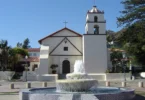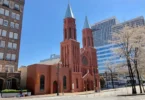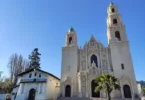
Introduction
Sanctuary of Our Lady of Rocamadour (or) Sanctuaire Notre-Dame de Rocamadour, France Pearl of Haut-Quercy, clinging to a cliff 150 meters above the Alzou valley, the religious city of Rocamadour has been attracting crowds since the 12th century.
Among so many anonymous people, Henri II Plantagenêt, Simon de Montfort, Blanche de Castille and his son Saint Louis IX, all the kings of France up to Louis XI, Saint Dominic, Saint Bernard, Saint Anthony of Padua, and more recently, Edmond Michelet, Francis Poulenc, etc.
Rocamadour and its many caves already housed people in the Paleolithic as shown in the cave drawings of the Grotte des Merveilles. The Grotte de Linars cave and its porch served as an underground necropolis and a habitat in the Bronze Age. The vestiges are deposited in the museum at Cabrerets and at the town hall in Rocamadour.
During the Iron Age, the Cadurques people arrived from middle Germany. In the eighth century BC., they colonised the current Lot department, using their iron weapons. The remains of a village, in the Salvate valley near Couzou, were found during work. An oppidum perched on the heights of the Alzou valley, downstream from Tournefeuille, is perhaps linked to the fight of the Gauls against the Roman troops during the Gallic war.
History of Sanctuary of Our Lady of Rocamadour, France
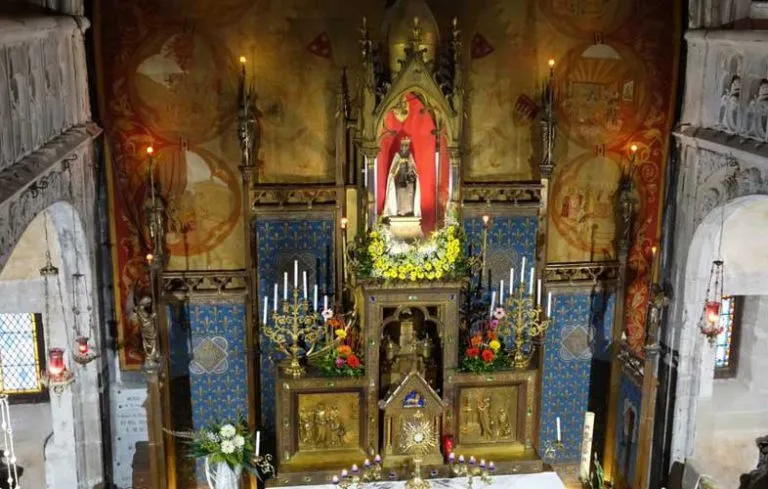
1105 – Pope Pascal II mentions the pilgrimage “to the Blessed Virgin Our Lady of Rocamadour”: the reputation of the pilgrimage has already gone beyond our borders. Rocamadour becomes one of the four holy places of Christianity: Jerusalem, Rome, Saint Jacques de Compostela and Rocamadour.
1152 – Géraud d’Escorailles, abbot of Saint Martin, decided to build a Sanctuary capable of welcoming crowds of pilgrims.
1166 – Discovery in front of the oratory of Notre-Dame, of the intact body of a hermit, attributed to Saint Amadour, servant of the Virgin Mary.
1172 – The Benedictines write the book of miracles: 126 miracles are authenticated.
1223 – After the franchises granted to the inhabitants by Géraud d’Escorailles, Bernard de Ventadour, recognizes “the commune of Rocamadour” and grants the industrial tribunal the first charter of customs. Economic life developed around the Benedictine priory.
1244 – Louis IX (Saint Louis) will come with his mother Blanche de Castille, and his brothers, to ask for happiness for France: the pilgrimage takes on a national dimension.
1562 – For the north of Quercy, “the most terrible year in its history”; the Sanctuary of Rocamadour is looted and the body of Saint Amadour is burned.
1643 – Alain de Solminihac traveled throughout his diocese on horseback. Louis XIII, by a judgment rendered in April 1643, reestablished the spiritual authority of the bishops of Cahors over the sanctuaries of Rocamadour. After the turmoil of the Revolution, holy priests will work for the rebirth of the sanctuary and the pilgrimage.
1836 – Father Caillau, in recognition of his recovery, will buy the old fortress on the plateau and will build “the castle”, intended to welcome priests and pilgrims.
1861 – Death of Blessed Pierre Bonhomme, parish priest of Gramat, who made the pilgrimage on foot once a week, and encouraged all the parishes of the diocese to come and confide in Our Lady at least once a year. He founded the congregation of nuns of Our Lady of Calvary; they are the ones who, even today, contribute to welcoming pilgrims on the way to Compostela.
Pilgrimage
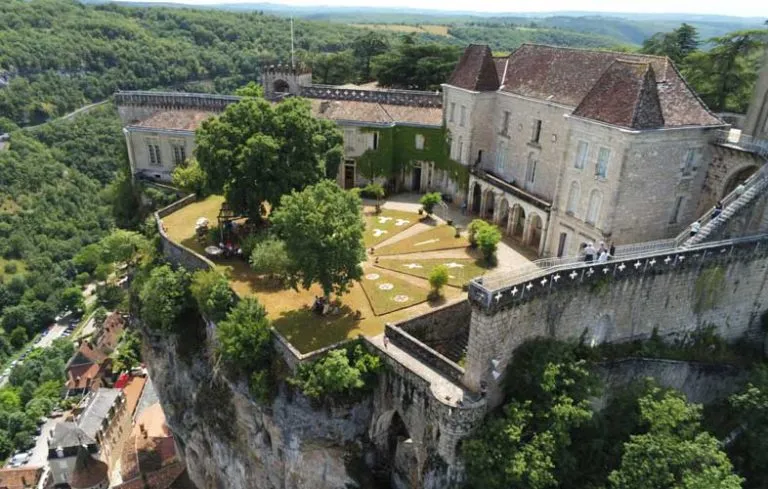
A legend supposed to explain the origin of this pilgrimage has given rise to controversies between critical and traditional schools, especially in recent times. A vehicle by which the legend was disseminated and pilgrims drawn to the site was The Miracles of Our Lady of Rocamadour, written ca. 1172, an example of the miracula, or books of collected miracles, which had such a wide audience in the Middle Ages.
According to the founding legend, Rocamadour is named after the founder of the ancient sanctuary, Saint Amator, identified with the Biblical Zacheus, the tax collector of Jericho mentioned in Luke 19:1-10, and the husband of St. Veronica, who wiped Jesus’ face on the way to Calvary.
Driven out of Palestine by persecution, St. Amadour and St. Veronica embarked in a frail skiff and, guided by an angel, landed on the coast of Aquitaine, where they met Bishop St. Martial, another disciple of Christ who was preaching the Gospel in the south-west of Gaul.
After journeying to Rome, where he witnessed the martyrdoms of St Peter and St Paul, Amadour, having returned to France, on the death of his spouse, withdrew to a wild spot in Quercy where he built a chapel in honour of the Blessed Virgin, near which he died a little later.
This account, like most other similar legends, does not make its first appearance till long after the age in which the chief actors are deemed to have lived. The name of Amadour occurs in no document previous to the compilation of his Acts, which on careful examination and on an application of the rules of the cursus to the text cannot be judged older than the 12th century.
It is now well established that Saint Martial, Amadour’s contemporary in the legend, lived in the 3rd not the 1st century, and Rome has never included him among the members of the Apostolic College. The mention, therefore, of St Martial in the “Acts of St Amadour” would alone suffice, even if other proof were wanting, to prove them doubtful.
The untrustworthiness of the legend has led some recent authors to suggest that Amadour was an unknown hermit or possibly St. Amator, Bishop of Auxerre, but this is mere hypothesis, without any historical basis.
The origin of the sanctuary of Rocamadour, lost in antiquity, is thus set down along with fabulous traditions which cannot bear up to sound criticism. After the religious manifestations of the Middle Ages, Rocamadour, as a result of war and the French Revolution, had become almost deserted. In the mid-nineteenth century, owing to the zeal and activity of the bishops of Cahors, it seems to have revived.
Rocamadour is classed as a World Heritage Site by UNESCO as part of the St James’ Way pilgrimage route.
The Black Madonna of Rocamadour - The Heart of Rocamadour
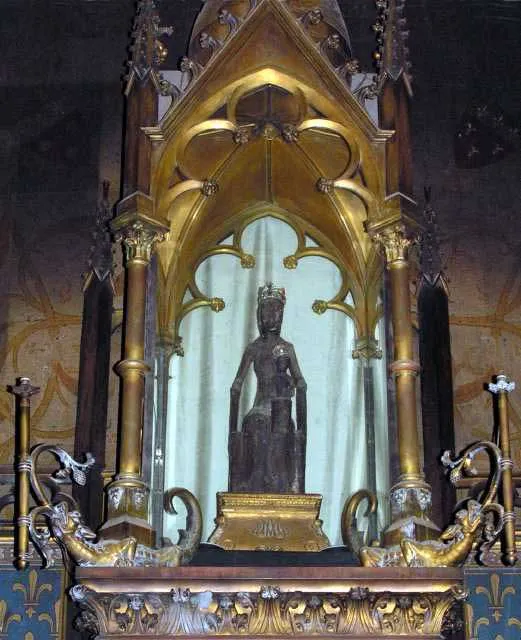
The whole story of Rocamadour begins where a mother’s heart has been beating for so long. In the darkness of its chapel, the visitor discovers the modest silhouette of a Virgin who is both mother and queen. It is to her that pilgrims have turned for eight centuries.
“I am black but beautiful”
This 12th century walnut statue is dark in color (more gray than black), but it was not always so: in the Middle Ages, it was entirely covered with precious metals and gems, such as is still today the statue of Sainte Foy in Conques. Wear and looting have gradually stripped it, and, for lack of means, we had to content ourselves with covering it with fabrics. The reason for this dark color is difficult to establish.
Recent studies have shown that it is neither due to the natural aging of the wood nor to a protective coating nor to the transfer of oxidation from metal coatings nor to the burning of candles or oil lamps. It is still unclear why it was blackened after being polychromed.
On the old altarpiece in which she was integrated before the current installation, which dates only from the end of the 19th century, a verse from the biblical book of the Song of Songs canonized in a way the mysterious patina of our Madonna: “Nigra sum sed formosa”, “I am black but beautiful”.
In the 20th century, the Litanies of the Black Virgin by composer Francis Poulenc contributed to making it known to the whole world.
History of the Black Madonna of Rocamadour
Rocamadour owes its origin to St Amadour, who, according to tradition, chose the place as a hermitage for his devotions to the Virgin Mary. This famous place of pilgrimage is most strikingly situated. Its buildings rise in stages up the side of a cliff on the right bank of the Alzou (Dordogne – France), which here runs between rocky walls 400 ft in height. Flights of steps ascend from the lower town to the churches a group of massive buildings half-way up the cliff. The chief of them is the church of NotreDame (1479) containing the wooden figure of the Madonna reputed to have been carved by St Amadour.
Rocamadour (250 km east from Bordeaux) became as important pilgrimage place in the Christian West as Santiago de Compostella. Thanks to the progress of the Marian cult and thanks to the discovery, in 1166, of the body of St. Amadour. Tradition records that he was a servant in the house of the Holy Family. St. Amadour who was none other than Zacheus of the Gospel husband of St. Veronica, who wiped the Saviour’s face on the way to Calvary Driven forth from Palestine by persecution.
Amadour and Veronica embarked in a frail skiff and guided by an angel landed on the coast of Aquitaine, where thy met Bishop St. Martial another disciple of Christ who was preaching the Gospel in the south-west of Gaul.
After journeying to Rome, where he witnessed the martydoms of St. Peter and Paul. Amadour having returned to France, on the death of his spouse, withdrew to a wild spot in Quercy where he built a chapel in honour of the Blessed Virgin, near which he died a little later. The shrine called Rocamadour sanctuary of the Blessed Virgin, has attracted pilgrims for centuries from every country among them kings, bishops and nobles.
Reports of miracles happening at the site spread rapidly. King Henry Plantagenet was one of the first pilgrims to come to Rocamadour to find a miraculous cure. St. Louis IX of France followed in the next century, and Rocamadour became as important as Mont St. Michel as a pilgrimage destination. Few people know that Rocamadour has thus become the second most visited site in France – after Mont St. Michel’s 12th century monastery.
Today’s visitors is advised to avoid the traditional activity of climbing up the 216 stone steps on one’s knees, but instead to sign up for a guided walking tour on one’s feet. This fascinating tour will take you to four of the seven medieval chapels built into the rock, one of which contains the mysterious Black Madonna, venerated for over a thousand years.
You’ll hear wonderful legends of how the body of St. Amadour was miraculously preserved for 1,100 years; how the ancient bell rings itself when a miracle occurs at sea how the sword in the rock you see in front of you is really the famous sword of Roland. Near the tomb of St. Amadour is the Church of the Black Madonna and the Mircaulous Bell.
“A natural colouring within the rock appears to portray an image of the Virgin Mary cradling baby Jesus. It is delineated below within the red border and only visible from lower down below the main town.”
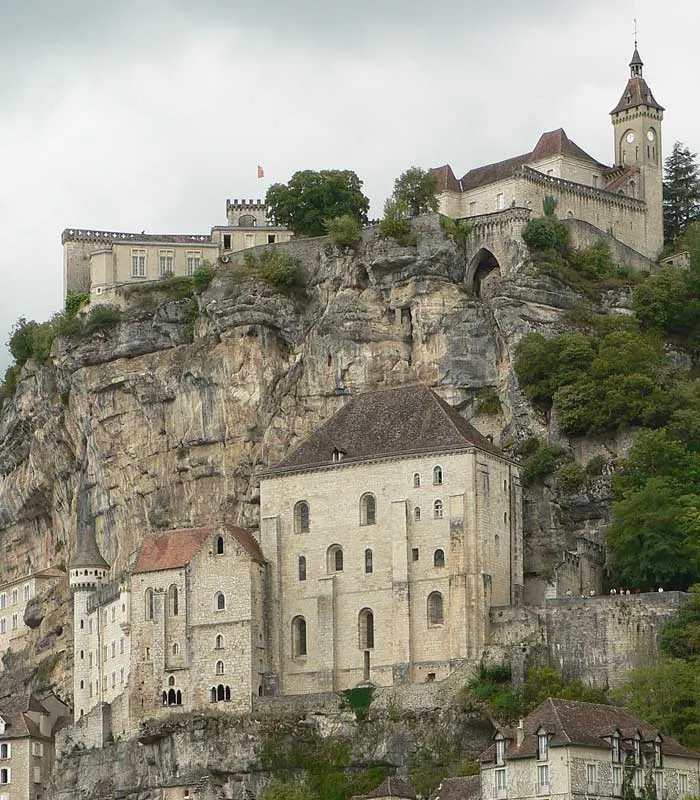
The Book of Miracles
The Virgin Mary had already been venerated in a tiny oratory for years when Géraud d’Escorailles, abbot of Saint-Martin de Tulle decided to build the Sanctuaries.
Three events will attract pilgrims to Rocamadour and will make this rock the fourth holiest site of Christianity in the 12th century:
- 1105 , Pope Paschal II writes a bull concerning the pilgrimage;
- 1166, discovery of the body of Saint-Amadour in front of the miraculous chapel.
- 1172, the monks realize many graces received at the feet of the Virgin Mary. They then decide to relate 126 miracles in a book.
This is the publicity needed to develop the pilgrimage. This book will shine around the world. It gives us a lot of information about medieval life. The original is kept at the National Library in Paris. Miracles are of all kinds. The motivations are not all medical, there are rescues at sea, signaled by the ringing of the bell, conversions of thieves, healings of the demon-possessed, prisoners freed from their irons, etc. Our Lady is attentive to all requests.
The 35th story of the book ends thus: “He gave thanks to Our Lady, his liberator, who saves those who put their hope in her, by the power of her Son the Savior of the world, who lives and reigns, Trine and One, in the ages of ages. Amen. »
Here is the story of a blind woman (miracle II, 19)
“A woman, whose name I do not have, originally from Burgundy, was in the hospital of Saint-Jean-Baptiste in Jerusalem. She was pregnant. While having her childbirth, she lost the use of the sight. After her relief, her husband led her through the streets of the city, the city of the sovereign King, to the very glorious church where he who was our salvation was hanged on the wood of the cross, where from all over the world , numerous faithful to adore this life-giving cross of the Lord. They both prayed in this place, so suitable for prayer where the Lord died, where He was buried. But they were not answered.
Disappointed in their hope, they turned their thoughts to the Blessed among the Blessed, to Our Lady of Rocamadour, and they promised to go to her sanctuary with the purse and the staff. Immediately the woman’s eyes opened. We can guess whether they praised and glorified the Star of the Sea who, with the radiance of his humility, irradiates our blinded souls and restores strength to our poor weakened limbs (excerpts from Jean Rocacher’s thesis, “Rocamadour and its pilgrimage”)
This is not a story that ends in the Middle Ages. Even today many thanks attest to miracles and graces received through the intercession of the Black Virgin.
The Miraculous Bell
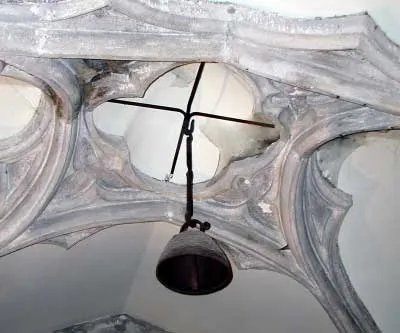
Within the Notre-Dame chapel is a miraculous bell. This miraculous bell, prior to the 9th century, of very rare manufacture since it was forged and not cast, without a windchest, with a sort of handle to suspend it from the vault. It bears witness to the protection of the Virgin Mary, “Star of the Sea”, for sailors in danger. A plaque indicates the dates when the bell rang by itself during Mary’s intercessions.
The book of miracles, dated 1172, recounts 126 wonders that occurred in Rocamadour through the intercession of the Virgin Mary. In Camaret, a chapel was erected in honor of Notre-Dame de Rocamadour. Even today, people attribute events to Notre-Dame de Rocamadour. Here are some examples:
In 1956, an Englishwoman suffering from multiple sclerosis returned from Lourdes where she was not cured. “Since that’s it, I’m stopping at Rocamadour! “. Christian, the son of the baker is serving as an altar at this time. He sees this lady arriving in a wooden wheelchair. Her legs are covered with bandages. She attends mass in the miraculous chapel, while Christian serves mass in the basilica. At communion, the lady gets up from her chair, she is healed. You can imagine the amazement of the chapel or the basilica, everyone comes to see it. Christian saw her leave, pushing her chair herself.
And each year, to thank the Virgin Mary, she arrived by the Holy Way, climbed the Grand Staircase, carrying flowers to Notre-Dame de Rocamadour. Christian remembers having seen it laden with a sheaf of gladioli.
On August 28, 2016, five knowledgeable and experienced sailors left the harbor of Brest aboard a sailboat in the direction of the Black Stones. The heavy weather expected the next day does not allow them to continue to Ouessant. They decide to return to Brest.
Sunday, August 29 after Sunday mass, they train in the harbor of Brest to do maneuvers. Everything is going well for the “man overboard” exercise, despite some nice gusts of wind. Until a brutal jibe which sends the balm to the other side of the edge, hitting Hubert violently in the head. He falls. Clement calls for help; Claire does everything so that Hubert does not lose consciousness; Marie, a member of the crew, tends to the bleeding wound.
Everyone knows the protection of Notre-Dame de Rocamadour for sailors; Marie had come as a volunteer to make visits to the Sanctuary in July. All their actions are accompanied by prayer to the Virgin Mary.
The rescuers arrived in 15 minutes on board an SNSM boat registered in Camaret and bearing the name of “Notre-Dame de Rocamadour”. Taken to the hospital, Hubert suffers from a head trauma. Today he has no after-effects and has resumed sailing. Marie came to give thanks to Rocamadour and to thank Our Lady on October 29, 2016.
Sights
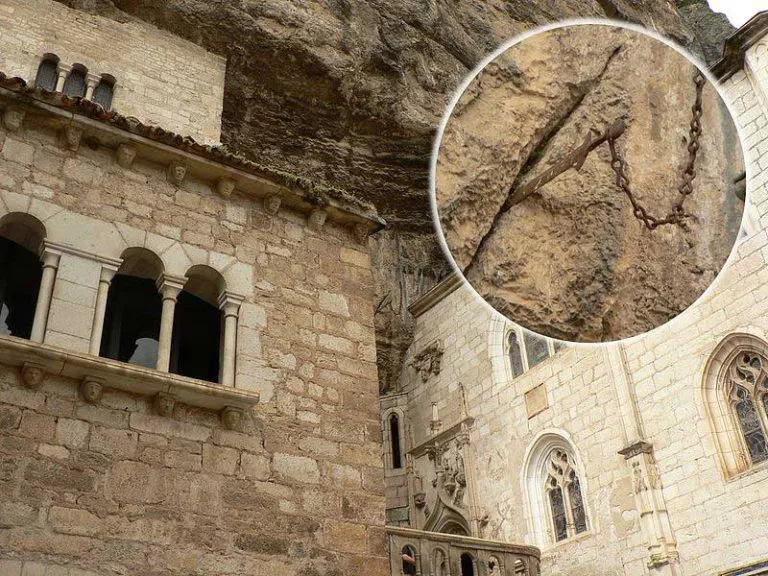
Rocamadour was a dependency of the abbey of Tulle to the north in the Bas Limousin. The buildings of Rocamadour (from ròca, cliff and saint Amador) rise in stages up the side of a cliff on the right bank of the Alzou, which runs between rocky walls 120 metres (390 ft) in height.
Flights of steps ascend from the lower town to the churches, a group of massive buildings half-way up the cliff. The chief of them is the pilgrimage church of Notre Dame (rebuilt in its present configuration from 1479), containing the cult image at the centre of the site, a wooden Black Madonna reputed to have been carved by Saint Amator (Amadour) himself.
The small Benedictine community continued to use the small twelfth-century church of Saint-Michel, above and to the side. Below, the pilgrimage church opens onto a terrace where pilgrims could assemble, called the Plateau of St Michel, where there is a broken sword said to be a fragment of Durandal, once wielded by the hero Roland.
The interior walls of the church of St. Sauveur are covered with paintings and inscriptions recalling the pilgrimages of celebrated people. The subterranean church of St. Amadour (1166) extends beneath St. Sauveur and contains relics of the saint. On the summit of the cliff stands the château built in the Middle Ages to defend the sanctuaries.
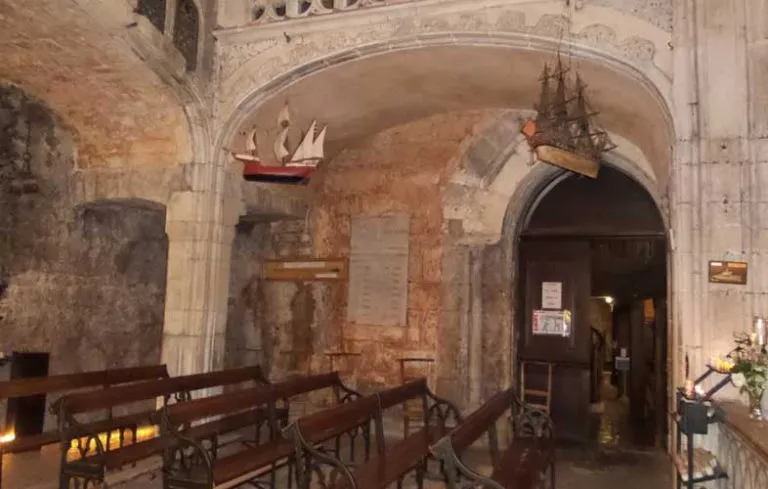
Feast Day - 20th August
The Annual Feast Day of Black Madonna of Rocamadour or Our Lady of Rocamadour held on 20th August.
Mass Time
Every days
Church Visiting Time
Contact Info
Sanctuary of Our Lady of Rocamadour,
Rue de la Haberdashery,
46500, Rocamadour, France.
Phone No.
Tel : +33 5 65 14 10 59
Accommodations
How to reach the Basilica
Brive–Souillac International Airport in France is the nearby Airport to the Sanctuary.
Rocamadour – Padirac Railway Station in Rocamadour, France is the nearby Train station to the Sanctuary.



